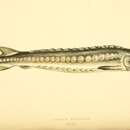Biology
provided by Arkive
Sturgeons are generally solitary, spending a number of years at sea before returning to the river where they were born, in order to breed in their turn. Entering the river in spring, mature individuals migrate upriver to the shallow spawning grounds (4). Females can produce between 200,000 and 6 million eggs, which are sticky so that they can attach to the gravel substrate (4). Mature individuals do not eat throughout the spawning migration (4). As the juveniles grow they begin to migrate downstream, and adult fish spend about seven to eight years at sea before reaching sexual maturity (7).
Sturgeon feed opportunistically on bottom dwelling creatures, feeling for prey amongst the mud with the sensitive barbels on their chin. Their food consists mainly of invertebrates and small fish (4).
Conservation
provided by Arkive
The European sea sturgeon is protected from international trade by its listing on Appendix I of the Convention on International Trade in Endangered Species (CITES) (3). A captive breeding programme (8) for the species is being undertaken with the long-term goal of reintroducing this 'dinosaur of the sea' to some of its former range.
Description
provided by Arkive
One of the largest European fish to breed in rivers, the European sea sturgeon has been fished to the brink of extinction principally as a source of caviar (2). This sturgeon has an olive-black upper body and a white belly (4). The elongated body tapers to a narrow pointed tip at the snout and lacks scales, apart from the five rows of whitish bony platelets, or scutes, which run the length of the fish (4). European sea sturgeon have sensitive barbels which are positioned on the lower jaw and are used to locate prey, which is then sucked into the mouth (4).
Habitat
provided by Arkive
Sturgeons are found near to the bottom of the water column, over a soft sandy or muddy substrate (6). Adults are found in the lower sections of large rivers and in the open sea, whilst spawning occurs upriver in shallow pools with a gravel base (6).
Range
provided by Arkive
Previously abundant along all European coasts, this sturgeon is today restricted to a single, reproductive population that breeds in the Gironde River, France (5).
Status
provided by Arkive
Classified as Critically Endangered (CR) on the IUCN Red List 2007 (1), and listed on Appendix I of CITES (3).
Threats
provided by Arkive
These long-lived and slow-growing fish are very vulnerable to exploitation; the European sea sturgeon has been extensively fished for its highly prized flesh and for the eggs, which are sold as caviar (6). The development of river systems, in particular the construction of hydroelectric dams, destroys the breeding habitat of this species and adults are no longer able to return to their natal rivers to breed (8). Today only a single reproductive population remains and the species is consequently extremely vulnerable to extinction (5).

